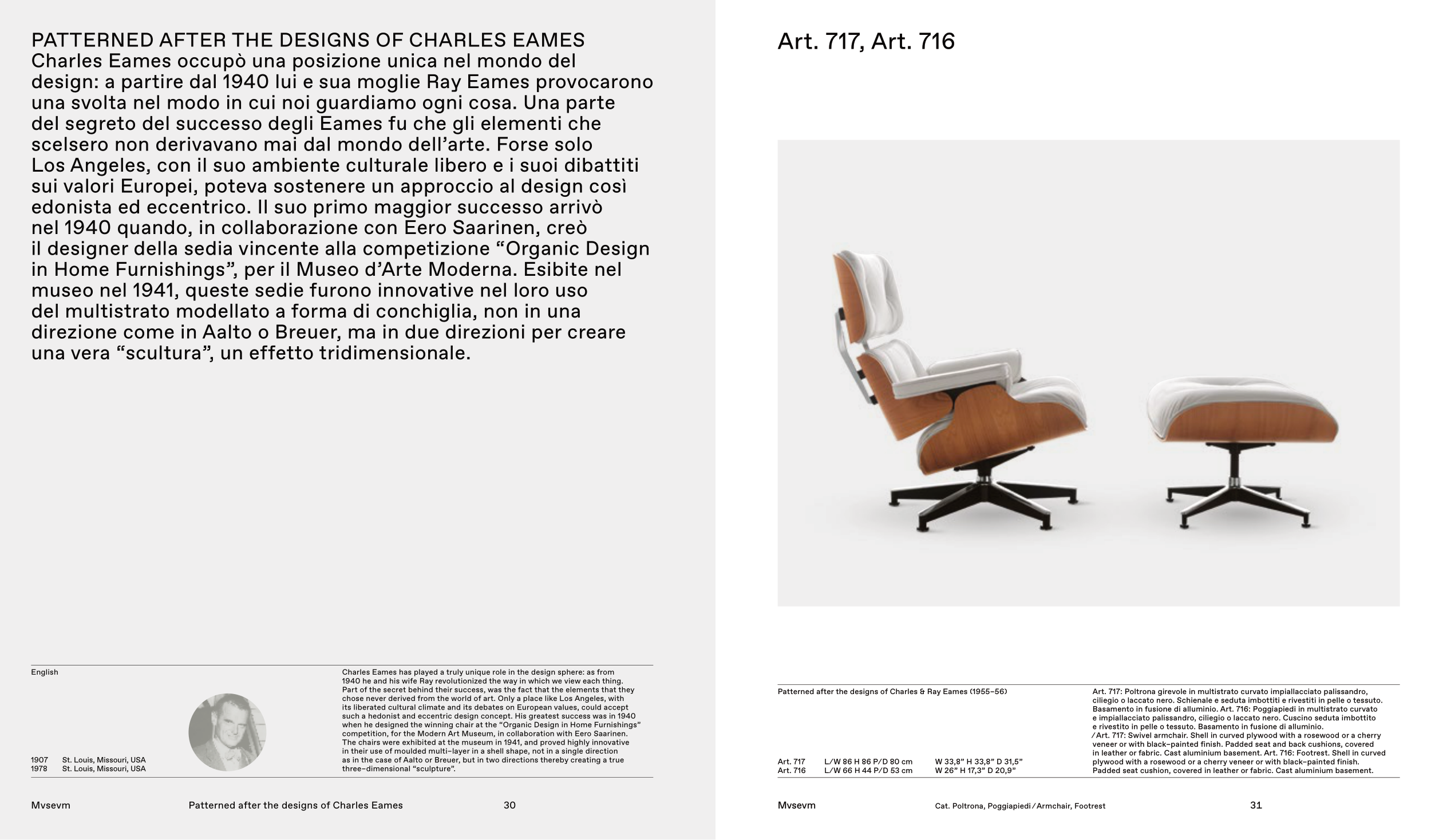30
31
Art. 717, Art. 716
Patterned after the designs of Charles & Ray Eames (1955–56)
Art. 717
L ⁄ W 86 H 86 P ⁄ D 80 cm
Art. 716
L ⁄ W 66 H 44 P ⁄ D 53 cm
W 33,8” H 33,8” D 31,5”
W 26” H 17,3” D 20,9”
Art. 717: Poltrona girevole in multistrato curvato impiallacciato palissandro,
ciliegio o laccato nero. Schienale e seduta imbottiti e rivestiti in pelle o tessuto.
Basamento in fusione di alluminio. Art. 716: Poggiapiedi in multistrato curvato
e impiallacciato palissandro, ciliegio o laccato nero. Cuscino seduta imbottito
e rivestito in pelle o tessuto. Basamento in fusione di alluminio.
⁄ Art. 717: Swivel armchair. Shell in curved plywood with a rosewood or a cherry
veneer or with black–painted finish. Padded seat and back cushions, covered
in leather or fabric. Cast aluminium basement. Art. 716: Footrest. Shell in curved
plywood with a rosewood or a cherry veneer or with black–painted finish.
Padded seat cushion, covered in leather or fabric. Cast aluminium basement.
Mvsevm
Cat. Poltrona, Poggiapiedi ⁄ Armchair, Footrest
PATTERNED AFTER THE DESIGNS OF CHARLES EAMES
Charles Eames occupò una posizione unica nel mondo del
design: a partire dal 1940 lui e sua moglie Ray Eames provocarono
una svolta nel modo in cui noi guardiamo ogni cosa. Una parte
del segreto del successo degli Eames fu che gli elementi che
scelsero non derivavano mai dal mondo dell’arte. Forse solo
Los Angeles, con il suo ambiente culturale libero e i suoi dibattiti
sui valori Europei, poteva sostenere un approccio al design così
edonista ed eccentrico. Il suo primo maggior successo arrivò
nel 1940 quando, in collaborazione con Eero Saarinen, creò
il designer della sedia vincente alla competizione “Organic Design
in Home Furnishings”, per il Museo d’Arte Moderna. Esibite nel
museo nel 1941, queste sedie furono innovative nel loro uso
del multistrato modellato a forma di conchiglia, non in una
direzione come in Aalto o Breuer, ma in due direzioni per creare
una vera “scultura”, un effetto tridimensionale.
Mvsevm
Patterned after the designs of Charles Eames
Charles Eames has played a truly unique role in the design sphere: as from
1940 he and his wife Ray revolutionized the way in which we view each thing.
Part of the secret behind their success, was the fact that the elements that they
chose never derived from the world of art. Only a place like Los Angeles, with
its liberated cultural climate and its debates on European values, could accept
such a hedonist and eccentric design concept. His greatest success was in 1940
when he designed the winning chair at the “Organic Design in Home Furnishings”
competition, for the Modern Art Museum, in collaboration with Eero Saarinen.
The chairs were exhibited at the museum in 1941, and proved highly innovative
in their use of moulded multi–layer in a shell shape, not in a single direction
as in the case of Aalto or Breuer, but in two directions thereby creating a true
three–dimensional “sculpture”.
1907
St. Louis, Missouri, USA
1978
St. Louis, Missouri, USA
English


